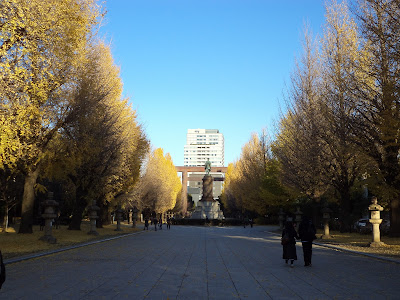On December 13th, 2012, we visited the Yasukuni Shrine and the Yushukan museum there. I was first surprised by how big, and beautiful the shrine itself is. First there was the Daiichi Tori (the fist shrine gate) and a pathway filled with yellow ginkgo trees. There was also a second Daiichi Tori which was the entrance to the actual shrine where many cherry trees were spread throughout the grounds.
Before checking out the main shrine area, we went to the Yushukan, a museum which according to Jeff Kingston "symbolizes the nexus of imperial expansion, militarism, and the cult of the emperor during the war years, ensuring that it remains a contemporary battleground over history" (Kingston 185). The Yushukan has been very controversial over the years, especially due to it's "enshrinement of 14 Class-A war criminals" (188). All the soldiers and certain citizens who are enshrined there (more than 2,466,000), were turned into kami or "gods." Therefore the enshrinement of war criminals as "gods" who fought for their country upsets many people.
I had heard a little bit about the shrine and museum before coming to Japan, but actually seeing the place was quite an interesting experience. The actual museum was pretty modern. When I had read or heard about the place before, I had pictured a smaller, dimly lit wooden building with exhibits all in Japanese. But the museum was bright, had multiple English translations (though not everything was translated), and has about 19 exhibition rooms. The first few rooms from "The Spirit of the Samurai" up until "The Satsuma Rebellion" seemed somewhat normal. Not too incredibly informative, but there didn't seem to be too much that was controversial (that I noticed).
Once I got to the room on the Sino-Japanese War, and from there on, the phrasing started to become more...interesting. I wish I could have taken pictures of all the "interesting" (or inaccurate phrasing I saw there, pictures were not allowed, since I had the greatest interest in this area, and the WWII area. There was one sign which talked about the "Korean Problem" and how Japan was trying to help Korea and wanted it to be free (but a later sign states how Korea was later annexed by Japan). There was also an interesting section which stated that other countries were inspired by Japan's time in Korea to fight for their own independence (which is ironic since Japan had conquered/tried to acquire some of those countries). In the Sino-Japanese war section, one sign made sure to point out how soldiers took "great care" in order to to harm civilians or loot the area in the Chinese city they were in...In the WWII rooms (which is called The Greater East Asia War in the museum), I found more controversial phrasings. One section mentioned how Roosevelt "went behind Japan's back" and gave Russia the islands which is why there is still problems with who owns those islands today. The list of sentences like this could go on and on. One section of the museum that really struck me were the exhibit rooms where pictures and items of the "Noble Spirits" where shown (somehow I ended up not seeing the war criminals here just because the museum was about to close). Seeing the pictures and letters from so many soldiers who died made me feel something that is hard to explain. I guess it just made me really sad. State Shintoism at the time seemed really, really scary to me. It's hard to believe that people felt so strongly about dying for the emperor. It's also scary to see how intense and disciplined Japanese militarism is in some ways since it seemed so focused on honoring the emperor and the country at the time.
As of now I'm still not sure how I feel about going to Yasukuni. A part of me wants to go back to the museum and spend more time reading all of the signs there, but a part of me never wants to go there again. Although it's a beautiful place, when I think of all the atrocities during wartime that are denied or never mentioned,it makes me sad and angry that such a place exists.









0 件のコメント:
コメントを投稿